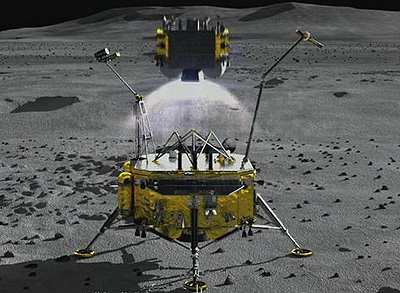Said to be its most ambitious lunar mission, China’s Chang’e-5 spacecraft lifted off from the Wenchang launch complex on a Long March 5 rocket on Tuesday, 24th November. The lunar mission aims to bring back lunar rock and soil and if everything goes as planned, the spacecraft should return by mid-December.
Chang’e-5 is going to target a nearside location called Mons Rumker, a high volcanic complex in a region known as Oceanus Procellarum. The rocks in this location are thought to be very young compared with those sampled by the US Apollo astronauts and the Soviet Luna robots – something like perhaps 1.3 billion years old versus the 3-4-billion-year-old rocks picked up on those earlier missions.
This will give scientists another data point for the method they use to age events in the inner Solar System. The success of the mission would the first opportunity scientists have had to study newly obtained lunar material since the American and Russian missions of the 1960s and 1970s.
China has already landed twice on the moon with its Chang’e 3 and Chang’e 4 missions. Its Chang’e 5 test mission in 2014 showed that it can navigate back to Earth, re-enter and land a capsule. Launched as a single space craft, Chang’e 5 is actually composed of a lander, ascender, service module and return capsule.
The lander will dig for materials with its drill and robotic arm and transfer them to the ascender, which will lift off from the moon and dock with the service capsule. The materials will then be moved to the return capsule for the trip home to earth. The technical complexity of Chang’e 5, with its four components, makes it “remarkable in many ways,” say space experts in US.
Space experts opine that the mission is among China’s boldest since it first put a man in space in 2003, becoming only the third nation to do so after the U.S. and Russia.

Chinese Lunar Exploration Program
The Chinese Lunar Exploration Program, also known as the Chang’e Project is named after the Chinese moon goddess Chang’e. It is an ongoing series of robotic Moon missions by the China National Space Administration (CNSA). The program incorporates lunar orbiters, landers, rovers and sample return spacecraft, launched using Long March rockets.
Launches and flights are monitored by a Telemetry, Tracking, and Command (TT&C) system, which uses 50-meter (160-foot) radio antennas in Beijing and 40-meter (130-foot) antennas in Kunming, Shanghai, and Ürümqi to form a 3,000-kilometer (1,900-mile) VLBI antenna. A proprietary ground application system is responsible for downlink data reception.
The first spacecraft of the program, the Chang’e 1 lunar orbiter, was launched from Xichang Satellite Launch Center on 24 October 2007, having been delayed from the initial planned date of 17–19 April 2007. A second orbiter, Chang’e 2, was launched on 1 October 2010. Chang’e 3, which includes a lander and rover, was launched on 1 December 2013 and successfully soft-landed on the Moon on 14 December 2013. Chang’e 4, which includes a lander and rover, was launched on 7 December 2018 and landed on 3 January 2019 on the South Pole-Aitken Basin, on the far side of the Moon.
The sample return mission, Chang’e 5, launched today is the latest of CNSA’s Lunar Exploration Programs.
